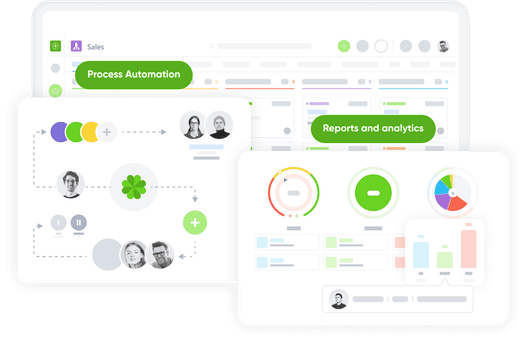Navigating Customer Retention: A Guide for Sustaining Client Relationships
In the dynamic realm of customer relations, the art of maintaining client satisfaction is as ancient as commerce itself.

With the ever-evolving business environment, the challenges of keeping clients content and engaged also transform. Neglecting the subtle cues that customers are not receiving their anticipated value can lead to a gradual shift away from your services, and perhaps even towards your competitors.
Securing the confidence of existing clients and earning the devotion of newcomers by consistently adding value is invaluable. Such trust paves a seamless transition from first-time buyers to repeat clients and renewals, fostering long-term prosperity and stability.
Drawing from a vast reservoir of experience, our team at Salesforce has observed a spectrum of customer interactions. As seasoned consultants, we offer strategic guidance and deep product knowledge, navigating through triumphs and tribulations alongside our clients. My own journey has involved direct engagement with hundreds of clients, spearheading strategic rescue missions for our most vulnerable accounts.
Amwork approach to identifying clients at risk of departure is twofold, encompassing both numerical data and human insight. Our refined strategy is encapsulated in three pivotal actions:
- Leverage analytics to identify clients at risk.
- Define the hallmarks of a satisfied, thriving client.
- Detect and address potential areas of friction.
Keeping Clients Engaged: Amwork Analytical Approach
We begin with the tangible—our analytics.
Our sophisticated data system gauges various metrics, such as license utilization, account maturity, and support interactions, amalgamating them into an overall “client health” snapshot. This process uncovers clients with outdated setups and quantifies their risk level.
However, reliance on data alone is insufficient. Our philosophy is to be “data-informed,” integrating numerical insights with qualitative evaluations. This approach mitigates the risks associated with data-only perspectives, such as overlooking on-the-ground feedback or missing crucial information. Moreover, the latency in data collection can mean missed opportunities for timely intervention.
Understanding the Traits of a Content Client
We then incorporate qualitative measures. By blending analytics with the personal aspects of client relationships, we can chart an effective strategy to either salvage a partnership or collaborate on new ventures.
At Salesforce, we adhere to six “Critical Success Factors,” essential for delivering value to every client:
- Partnership ethos: Does Salesforce act as a vital, strategic partner rather than just a supplier?
- Leadership engagement: Is there a robust connection between Salesforce and the client's executive team?
- Value creation: Are we jointly driving measurable outcomes and value?
- Resource adequacy: Does the client possess the necessary resources and expertise to implement and utilize the product effectively?
- Technical debt management: Is there a clear strategy to address and resolve technical debt?
- Product-fit precision: Are the client's objectives being met through the correct use of products and services?
By adhering to these principles, we not only anticipate potential client disengagement but also create a proactive environment for client success. This guide serves as a beacon for businesses aiming to not just retain but also deepen their client relationships, ensuring a legacy of mutual growth and success.
Strategic Customer Retention: Crafting a Blueprint for Client Satisfaction
Our team of success experts at Salesforce conducts a comprehensive evaluation of each critical factor alongside our data signals. This dual analysis is crucial for identifying elements that may compromise the health of a customer's account and for highlighting opportunities for growth and improvement. The art of data storytelling enables us to proactively address potential issues and discover new business opportunities.
Proactive Customer Engagement: The Heart of the Matter
At the core of our strategy is a proactive approach. By conducting thorough audits of our extensive customer base, using data signals as our guide, we preempt potential challenges. We proactively identify current or emerging issues and opportunities for improvement before a customer considers alternative options.
The integration of data and individual feedback allows companies to tailor their strategies to ensure customer satisfaction. This personalized touch is fundamental to our philosophy.
Consistency in Review: The Rhythm of Success
A regular review schedule is also essential. With a dedicated team focused on customer success and a robust governance model that dictates the frequency and targets of customer engagement, we maintain smooth operations.
Our method, when executed with care, provides a comprehensive view of a customer's overall health. Comparable to a physician's routine
Blueprint for Customer Contentment: A Tailored Approach
In any industry and at any size, companies can combine data with client feedback to develop a customized strategy for customer satisfaction. It starts with identifying your data signals—proactive, quantifiable indicators of your success factors. Determine what attracts customers to your business and represent this in measurable terms. For example, in customer service, you might analyze how average case handling times differ among clients. These signals will vary depending on your services or products and the intentions of your customers.
Setting benchmarks for these signals is essential to categorize customer health and to define the corresponding actions for each category.
Next, identify your qualitative success factors. These could be as few as two or as many as ten. Consider what makes a relationship between your business, your customers, and their goals with your product or service robust and satisfying. Develop a method for collecting these success factors—initial research could be through customer surveys, testimonials, or a listening tour.
Adaptation and Evolution: The Constants of Business
Be ready to adapt, as your business changes, so too will your data signals and success factors. Continuous improvement is imperative. Internal committees can provide a consistent feedback loop, defining customer satisfaction and preventing attrition. This ongoing process not only avoids customer loss but also ensures that clients remain happy and derive real value from your services.

Emily Johnson
Share





